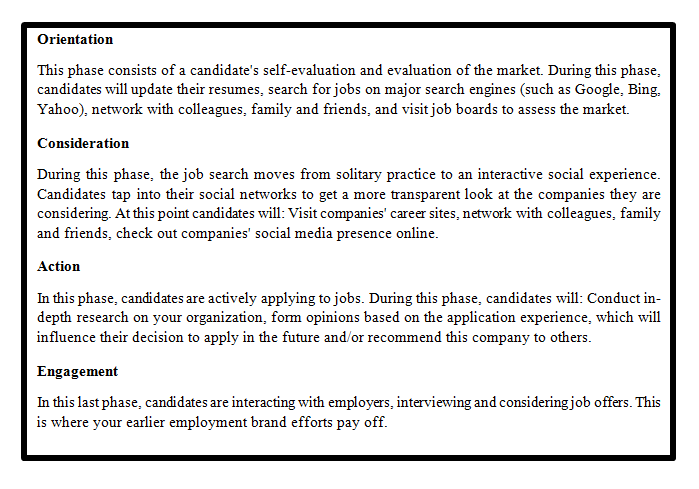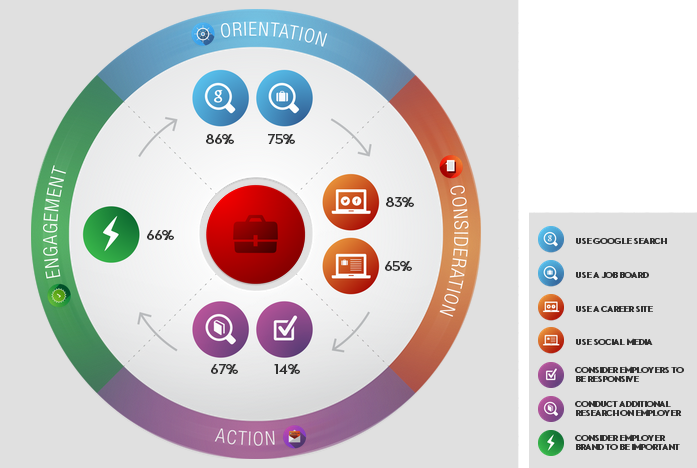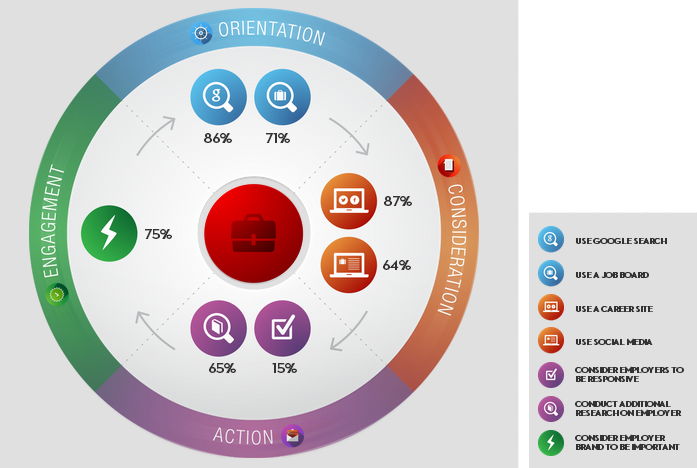
by Fronetics | Jul 30, 2014 | Blog, Marketing, Social Media, Strategy, Supply Chain, Talent

Source: www.social-hire.com
Great talent is out there. The question is – where? With more than 73 percent of online adults and 89 percent of job seekers using social networking sites the answer is clear – online.
Many companies employ a strategy of “post and pray.” That is, they post the job on their website and then they sit back and wait for the applications to pour in. If you want to attract top talent, you need to move away from post and pray and instead use an active talent acquisition strategy.
Here are the components of an active strategy– one that will enable your company to attract and land top talent.
Post
In addition to posting the job description on your company’s website, post it on industry job boards and on LinkedIn.
Share
LinkedIn, Twitter, and Facebook are great places to share that your company has an opening and is looking for great talent. When using social media to share the job posting remember that, for example, the lifespan of a Tweet is about 18 minutes. Given this, it is necessary to share the job opening more than once so that it doesn’t get lost in the chatter.
Explore
Go out and look for talent. Look to the LinkedIn groups to which you belong. Are there individuals who, given their contributions to the group, seem like they would be a good fit for the position? If so, reach out to them and let them know they caught your attention. Share the position with them, and go from there.
Similarly, look to Twitter and to blogs. When looking at blogs to identify a potential candidate, look not only at the author, but also at people mentioned within a blog post.
Network
Use your network and your employee’s networks to share the position and to identify potential candidates.
The next time you have a job opening, try an active strategy. You’ll be amazed – an active approach to talent acquisition will yield a stronger pool of candidates.

by Fronetics | Jul 24, 2014 | Blog, Leadership, Marketing, Social Media, Strategy, Supply Chain, Talent

The supply chain industry has a talent crisis. The question is: how can we solve this crisis? To answer this question I turned to Rodney Apple, founder of the SCM Talent Group. Apple has worked as a supply chain recruiter for the majority of his 19+ year career within the staffing industry and he has filled more than 1,000 positions within the industry ranging from executive-level in Fortune 500 headquarters settings to leadership and staff-level roles across large networks of manufacturing and distribution facilities within North America. Apple’s role affords him the ability to witness the talent crisis from the perspective of the industry, the company, and the job seeker.
Kate Lee: The supply chain talent crisis is a hot topic. Is the job market as crazy as it is being made out to be?
Rodney Apple: The job market has been hot for years and there is always a crunch to find and source top supply chain talent. Baby Boomers are retiring in droves and there just aren’t enough people with the necessary skills and experience coming in to fill that gap. With that being said, I don’t think the job market is as crazy as the media makes it out to be. However, we still need the media to continue researching and reporting on this critical topic as this builds more awareness and helps to generate new ideas and solutions for solving the talent problem.
Lee: When it comes to supply chain talent, what is the biggest challenge?
Apple: We don’t have enough students at the K-12 levels that are saying “when I grow up, I want to be a Supply Chain Manager.” Many students coming up through our educational ranks don’t even know what supply chain is or they perceive supply chain as a blue collar industry where you either drive freight trucks or load and unload them at a warehouse dock.
There needs to be big thinking and big solutions to change this image at the macro level. The industry needs to make a concerted effort to communicate to K-12 students what supply chain is and what the career paths look like. Ultimately, it needs to find a way to brand supply chain as a top career choice. Investing into K-12 outreach programs and mass media campaigns, similar to how our military branches advertise for recruiting purposes, could be a great way to educate the future workforce about the supply chain and get them excited about pursuing degrees and careers within supply chain.
Lee: What other challenges do you see?
Many companies haven’t taken the initiative to develop best-in-class talent acquisition resources and programs. Companies that perform the best are the ones that treat the recruiting department like a strategic, value-added program versus a low-level, tactical HR cost center.
In addition, many companies are being too strict and inflexible with their hiring requirements. Instead of defining the job when they write out their job descriptions, they focus on defining the candidate by listing out a ridiculously long and unrealistic list of skills and qualifications that the “ideal candidate” must have to be “qualified”. This antiquated technique usually ends up deterring top candidates from applying and disqualifies candidates that have what it takes to do the job.
Lee: What can companies do to attract top talent?
Apple:
- Develop a best-in-class talent acquisition strategy and program
o People – hire the best talent sourcers and recruiters that you can find and make sure you have a properly staffed department so they’ll operate in a “proactive” versus “reactive” capacity.
o Process –streamline the end-to-end talent acquisition process with the goal of alleviating administrative, burdensome tasks and unnecessary touch points.
o System – implement a robust Applicant Tracking System, one that integrates with the company career site and ideally the HRIS or ERP system.
o Employee Referral Program – referrals are typically the top source for hires so companies should invest into developing a best-in-class employee referral program. Get the CEO and all senior executives to champion the program so all employees are involved and incented to participate.
o College Recruiting Program – partner with supply chain universities and proactively recruit students from these universities, early and often.
o External Supply Chain Recruiting Partners – identify supply chain recruiting agencies that specialize in the areas where hiring help is needed the most.
- Upgrade Career Branding Materials – Develop attractive branding/marketing materials to include a separate company career website that highlights company culture, history, key stats, job opportunities, career paths, etc. Incorporate interviews from employees and testimonials that illustrate why your company is a great place to work. In addition, learn how to write job descriptions that attract top supply chain talent.
- Create a Supply Chain Leadership Development Program –This is a great and cost-effective way to attract top entry-level talent and aggressively train and ramp them up to speed by rotating them into different functional areas within the supply chain. GE is well known for having best-in-class leadership development programs.
- Be open-minded when it comes to considering top talent from other fields/industries. Many candidates in other professionals have very transferable skill sets for careers within supply chain.
- Develop a program for employing Veterans, candidates with disabilities and long-term unemployed.
- Invest more into job training and mentoring programs e.g. supply chain certifications and tuition reimbursement.
Lee: What is the role of social media in recruitment?
Apple: Companies and their recruiters need to be on social media to establish their employment brand, to attract talent, and to share job openings and upcoming recruitment events. Furthermore, social media can be leveraged by all employees as a talent acquisition tool. For example, companies could require all employees to distribute jobs out to their social media connections/networks.
Lee: What advice do you have for job seekers?
Apple: A job search should be conducted strategically, not haphazardly. It’s all about laying out a robust job search strategy with a corresponding action plan. In addition, networking is where job seekers should spend the bulk of their time versus applying online and waiting for the phone to ring.
Lee: Do you have any advice for job seekers trying to break into the supply chain industry?
Apple: Changing industries is tough to do but not impossible. Start by looking at what skills are transferrable and highlight these skills on your resume, LinkedIn profile, and in interviews. In some cases going back to school may be necessary. This may mean a degree program, or it could mean obtaining a supply chain certificate.
Networking is paramount. Join local chapters of supply chain associations, attend their meetings and network your butt off.
Finally, remember that it may be necessary to take a step back in both job level and compensation. Often times taking one small step back in your career could result in three giant leaps forward.

by Fronetics | Jul 24, 2014 | Blog, Leadership, Marketing, Social Media, Strategy, Supply Chain, Talent

The supply chain industry has a talent crisis. The question is: how can we solve this crisis? To answer this question I turned to Rodney Apple, founder of the SCM Talent Group. Apple has worked as a supply chain recruiter for the majority of his 19+ year career within the staffing industry and he has filled more than 1,000 positions within the industry ranging from executive-level in Fortune 500 headquarters settings to leadership and staff-level roles across large networks of manufacturing and distribution facilities within North America. Apple’s role affords him the ability to witness the talent crisis from the perspective of the industry, the company, and the job seeker.
Kate Lee: The supply chain talent crisis is a hot topic. Is the job market as crazy as it is being made out to be?
Rodney Apple: The job market has been hot for years and there is always a crunch to find and source top supply chain talent. Baby Boomers are retiring in droves and there just aren’t enough people with the necessary skills and experience coming in to fill that gap. With that being said, I don’t think the job market is as crazy as the media makes it out to be. However, we still need the media to continue researching and reporting on this critical topic as this builds more awareness and helps to generate new ideas and solutions for solving the talent problem.
Lee: When it comes to supply chain talent, what is the biggest challenge?
Apple: We don’t have enough students at the K-12 levels that are saying “when I grow up, I want to be a Supply Chain Manager.” Many students coming up through our educational ranks don’t even know what supply chain is or they perceive supply chain as a blue collar industry where you either drive freight trucks or load and unload them at a warehouse dock.
There needs to be big thinking and big solutions to change this image at the macro level. The industry needs to make a concerted effort to communicate to K-12 students what supply chain is and what the career paths look like. Ultimately, it needs to find a way to brand supply chain as a top career choice. Investing into K-12 outreach programs and mass media campaigns, similar to how our military branches advertise for recruiting purposes, could be a great way to educate the future workforce about the supply chain and get them excited about pursuing degrees and careers within supply chain.
Lee: What other challenges do you see?
Many companies haven’t taken the initiative to develop best-in-class talent acquisition resources and programs. Companies that perform the best are the ones that treat the recruiting department like a strategic, value-added program versus a low-level, tactical HR cost center.
In addition, many companies are being too strict and inflexible with their hiring requirements. Instead of defining the job when they write out their job descriptions, they focus on defining the candidate by listing out a ridiculously long and unrealistic list of skills and qualifications that the “ideal candidate” must have to be “qualified”. This antiquated technique usually ends up deterring top candidates from applying and disqualifies candidates that have what it takes to do the job.
Lee: What can companies do to attract top talent?
Apple:
- Develop a best-in-class talent acquisition strategy and program
o People – hire the best talent sourcers and recruiters that you can find and make sure you have a properly staffed department so they’ll operate in a “proactive” versus “reactive” capacity.
o Process –streamline the end-to-end talent acquisition process with the goal of alleviating administrative, burdensome tasks and unnecessary touch points.
o System – implement a robust Applicant Tracking System, one that integrates with the company career site and ideally the HRIS or ERP system.
o Employee Referral Program – referrals are typically the top source for hires so companies should invest into developing a best-in-class employee referral program. Get the CEO and all senior executives to champion the program so all employees are involved and incented to participate.
o College Recruiting Program – partner with supply chain universities and proactively recruit students from these universities, early and often.
o External Supply Chain Recruiting Partners – identify supply chain recruiting agencies that specialize in the areas where hiring help is needed the most.
- Upgrade Career Branding Materials – Develop attractive branding/marketing materials to include a separate company career website that highlights company culture, history, key stats, job opportunities, career paths, etc. Incorporate interviews from employees and testimonials that illustrate why your company is a great place to work. In addition, learn how to write job descriptions that attract top supply chain talent.
- Create a Supply Chain Leadership Development Program –This is a great and cost-effective way to attract top entry-level talent and aggressively train and ramp them up to speed by rotating them into different functional areas within the supply chain. GE is well known for having best-in-class leadership development programs.
- Be open-minded when it comes to considering top talent from other fields/industries. Many candidates in other professionals have very transferable skill sets for careers within supply chain.
- Develop a program for employing Veterans, candidates with disabilities and long-term unemployed.
- Invest more into job training and mentoring programs e.g. supply chain certifications and tuition reimbursement.
Lee: What is the role of social media in recruitment?
Apple: Companies and their recruiters need to be on social media to establish their employment brand, to attract talent, and to share job openings and upcoming recruitment events. Furthermore, social media can be leveraged by all employees as a talent acquisition tool. For example, companies could require all employees to distribute jobs out to their social media connections/networks.
Lee: What advice do you have for job seekers?
Apple: A job search should be conducted strategically, not haphazardly. It’s all about laying out a robust job search strategy with a corresponding action plan. In addition, networking is where job seekers should spend the bulk of their time versus applying online and waiting for the phone to ring.
Lee: Do you have any advice for job seekers trying to break into the supply chain industry?
Apple: Changing industries is tough to do but not impossible. Start by looking at what skills are transferrable and highlight these skills on your resume, LinkedIn profile, and in interviews. In some cases going back to school may be necessary. This may mean a degree program, or it could mean obtaining a supply chain certificate.
Networking is paramount. Join local chapters of supply chain associations, attend their meetings and network your butt off.
Finally, remember that it may be necessary to take a step back in both job level and compensation. Often times taking one small step back in your career could result in three giant leaps forward.

by Fronetics | Jul 16, 2014 | Blog, Manufacturing & Distribution, Marketing, Social Media, Strategy, Supply Chain, Talent, Warehousing & Materials Handling
According to the 2013 CareerBuilder Candidate Behavior Study, job seekers looking for a position with the manufacturing, transportation, and warehousing industries are using the internet and social media not only to look for jobs, but also to research companies within these industries.
Candidates use the internet and social media throughout their job search
The CareerBuilder study looked at the behavior of candidates throughout the four phases of their job search (orientation, consideration, action, and engagement) and found that the internet and social media were used throughout each of the phases. (See Figure 1 for a definition of each of the four phases.)
Figure 1: The four phases of the the job search
 Source: 2013 CareerBuilder Candidate Behavior Study
Source: 2013 CareerBuilder Candidate Behavior Study
Job seekers in the orientation and consideration phases have not yet applied for a job at your company. Instead they are assessing the market, learning about an industry, and learning about companies within the industry. These stages are very much knowledge seeking phases for the candidate. Companies who are positioned right can attract great talent during these phases. However, companies who do not have a strong online presence and who do not participate in social media will not catch the eye of job seekers. Think of it as speed dating – you only have a short period of time to make an impression. According to the Neilson Norman Group you have 10 to 20 seconds to make that great impression. If you don’t make a great impression during those few seconds the user will navigate away from your website. Therefore you need to make sure that your website is visually engaging, easy to navigate, and contains quality and informative content.
When a candidate reaches the action stage they not only apply to jobs, they also conduct more in-depth research about a company, and form opinions based on the application experience. Candidates are not afraid to share their experience with the application process. Fifty percent of candidates share bad experiences with others and 64 percent share positive experiences.
In the engagement stage candidates interact with employers, interview for positions, and consider offers. Ninety-one percent of candidates believe employment brand plays a role in their decision whether or not to apply – therefore it is at this stage where your company’s online presence and participation in social media pays off.
How do candidates looking for a position within the manufacturing, transportation, and warehousing industries approach their job search? Let’s look.
Manufacturing industry
As shown in Figure 2, within the orientation stage, 85 percent of candidates looking for a job within the manufacturing industry turned to Google and 75 used a job board. In the consideration stage 83 percent used a company’s career site and 65 percent used social media to learn more about the company.
In the action stage 67 percent of candidates reported that they conducted additional research on an employer. In this stage only 14 percent of candidates reported employers in the manufacturing industry to be responsive.
Finally, looking at the final stage of the candidate’s journey, 67 percent reported that they felt the employer brand to be important.
Figure 2: The four phases of the job search; manufacturing industry

Source: 2013 CareerBuilder Candidate Behavior Study
Transportation and warehousing industries
Figure 3 shows that within the orientation stage 86 percent of candidates looking for a job within the transportation and warehousing industries turned to Google and 71 percent used a job board. In the consideration stage 87 percent used a company’s career site and 64 percent used social media to learn more about the company.
In the action stage 65 percent of candidates reported that they conducted additional research on an employer. In this stage only 15 percent of candidates reported employers to be responsive.
In the engagement phase, 75 percent of candidates reported that they felt the employer brand to be important.
Figure 3: The four phases of the job search; manufacturing industry

Source: 2013 CareerBuilder Candidate Behavior Study
In the end
Candidates looking for jobs within the manufacturing, transportation, and warehousing industries are using the internet and social media. They are researching these industries and researching companies within these industries. They are forming opinions, acting on these opinions, and sharing their opinions with others.
If the manufacturing, transportation, and warehousing industries want to attract great talent and retain their interest throughout a candidate’s job search they need to invest in their online presence and become active in social media.

by Fronetics | Jul 16, 2014 | Blog, Manufacturing & Distribution, Marketing, Social Media, Strategy, Supply Chain, Talent, Warehousing & Materials Handling
According to the 2013 CareerBuilder Candidate Behavior Study, job seekers looking for a position with the manufacturing, transportation, and warehousing industries are using the internet and social media not only to look for jobs, but also to research companies within these industries.
Candidates use the internet and social media throughout their job search
The CareerBuilder study looked at the behavior of candidates throughout the four phases of their job search (orientation, consideration, action, and engagement) and found that the internet and social media were used throughout each of the phases. (See Figure 1 for a definition of each of the four phases.)
Figure 1: The four phases of the the job search
 Source: 2013 CareerBuilder Candidate Behavior Study
Source: 2013 CareerBuilder Candidate Behavior Study
Job seekers in the orientation and consideration phases have not yet applied for a job at your company. Instead they are assessing the market, learning about an industry, and learning about companies within the industry. These stages are very much knowledge seeking phases for the candidate. Companies who are positioned right can attract great talent during these phases. However, companies who do not have a strong online presence and who do not participate in social media will not catch the eye of job seekers. Think of it as speed dating – you only have a short period of time to make an impression. According to the Neilson Norman Group you have 10 to 20 seconds to make that great impression. If you don’t make a great impression during those few seconds the user will navigate away from your website. Therefore you need to make sure that your website is visually engaging, easy to navigate, and contains quality and informative content.
When a candidate reaches the action stage they not only apply to jobs, they also conduct more in-depth research about a company, and form opinions based on the application experience. Candidates are not afraid to share their experience with the application process. Fifty percent of candidates share bad experiences with others and 64 percent share positive experiences.
In the engagement stage candidates interact with employers, interview for positions, and consider offers. Ninety-one percent of candidates believe employment brand plays a role in their decision whether or not to apply – therefore it is at this stage where your company’s online presence and participation in social media pays off.
How do candidates looking for a position within the manufacturing, transportation, and warehousing industries approach their job search? Let’s look.
Manufacturing industry
As shown in Figure 2, within the orientation stage, 85 percent of candidates looking for a job within the manufacturing industry turned to Google and 75 used a job board. In the consideration stage 83 percent used a company’s career site and 65 percent used social media to learn more about the company.
In the action stage 67 percent of candidates reported that they conducted additional research on an employer. In this stage only 14 percent of candidates reported employers in the manufacturing industry to be responsive.
Finally, looking at the final stage of the candidate’s journey, 67 percent reported that they felt the employer brand to be important.
Figure 2: The four phases of the job search; manufacturing industry

Source: 2013 CareerBuilder Candidate Behavior Study
Transportation and warehousing industries
Figure 3 shows that within the orientation stage 86 percent of candidates looking for a job within the transportation and warehousing industries turned to Google and 71 percent used a job board. In the consideration stage 87 percent used a company’s career site and 64 percent used social media to learn more about the company.
In the action stage 65 percent of candidates reported that they conducted additional research on an employer. In this stage only 15 percent of candidates reported employers to be responsive.
In the engagement phase, 75 percent of candidates reported that they felt the employer brand to be important.
Figure 3: The four phases of the job search; manufacturing industry

Source: 2013 CareerBuilder Candidate Behavior Study
In the end
Candidates looking for jobs within the manufacturing, transportation, and warehousing industries are using the internet and social media. They are researching these industries and researching companies within these industries. They are forming opinions, acting on these opinions, and sharing their opinions with others.
If the manufacturing, transportation, and warehousing industries want to attract great talent and retain their interest throughout a candidate’s job search they need to invest in their online presence and become active in social media.

by Fronetics | Jul 15, 2014 | Blog, Marketing, Social Media, Strategy, Supply Chain, Talent
If the supply chain industry is going to attract new and qualified talent, it needs a face lift. The industry needs to be proactive. It needs to communicate what it is, what is currently happening within the industry, and what is in store for the future.
Who is responsible for making change possible? You.
Job seekers turn to the Internet for information. Job seekers not only use the internet to search for job openings, they also use the Internet to research industries, companies, and key players. The information job seekers gather by looking at websites, blog posts, articles, and social media shape their opinion and knowledge. According to the 2013 CareerBuilder Candidate Behavior Study 63 percent of job seekers turn to social media to learn about the employment brand of a company. Specifically, job seekers look to social media to learn about the culture of a company, to learn if the company is a thought leader, and to determine the authenticity of the employment brand.

Job seekers are likely seeing sensational headlines like this recent one from Forbes: Wanted: 1.4 million new supply chain workers by 2018. But what do they find when they move forward with their search for information on the supply chain industry and on your company?
The reality is that the supply chain industry has been slow to participate in social media and has been remiss when it comes to blogging. Even more basic, many companies within the supply chain industry do not recognize the value of their website and have created sites which provide little to no helpful information, are difficult to navigate, and are not up to date.
According to the CareerBuilder Study, 91 percent of candidates believe employment brand plays a role in their decision whether or not to apply.
If your company is going to attract great supply chain talent you need to step up to the plate. Make changes to your website, create and curate great content, and get active on social media.
Great talent is on the Internet. If you want to attract great talent you need to be there too.







